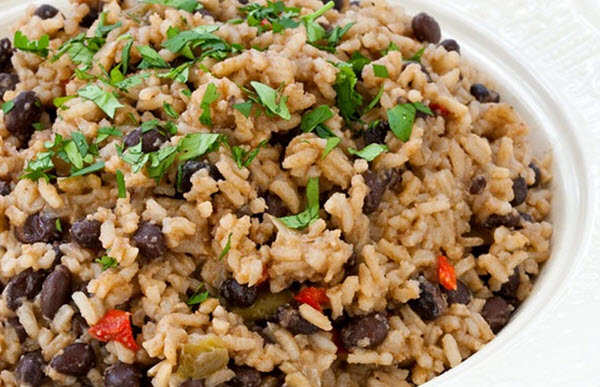Moros y Cristianos

Moros y Cristianos is a Cuban dish with white rice and black beans. Rice + beans is a very common combination throughout the Caribbean as well as in many other parts of the Americas. There is for instance the Nicaraguan Gallo Pinto, the Arroz con Gandules of Puerto Rico, the Venezuelan Pabellón Criollo and the Hoppin’ John of southern USA.
Moros y Cristianos is Spanish for Moors and Christians, where the black beans symbolizes the Moors and the Christians are represented by the white rice. In Cuba, Moros y Cristianos is available in most restaurants and is also a common home-cooked everyday meal. It is often referred to simply as moros, moro or arroz moro.
The beans are cooked separately from the rice when making Moros y Cristianos, which distinguishes it from the African-influenced dish Congri where rice and beans are cooked in the same pot.
In addition to black beans and white rice, Moros y Cristianos will usually include some vegetables and spices. Onions, garlic, bell pepper, oregano, cumin and bay leaf are all examples of popular choices.
Recipe for Moros y Cristianos
Ingredients for the beans
- 1 pound dried black beans
- Plenty of water
- 1 pound smoked ham hocks or ham shanks (can be substituted with salted pork)
- 2 bay leaves
- Salt to taste
Ingredients for the rice
- 1 cup long grain rice
- 2 tablespoons olive oil
- 1 teaspoon salt
- 2 cloves garlic
- 2 cups water
Ingredients for the sofrito
- 4 tablespoons olive oil
- 4 tomatoes, chopped
- 2 bell peppers, chopped
- 2 medium-size yellow onions, peeled and chopped
- 10 garlic cloves, peeled and diced
- 2 teaspoons ground cumin
- 2 teaspoons dried oregano
- 1 teaspoon paprika
Instructions
Soaking the beans
The dry beans should be left to soak for several hours to become moist again. Usually, this is done over night.
First, sort the beans and discard any bad ones, plus any other debris such as pebbles. Then, rinse the good beans well, and place them in a large pot and cover them with water. The water’s surface should be at least one inch above the beans.
Cooking the beans
- Drain the water that the beans have been soaking in overnight and discard it.
- Add new water to the bean pot, making sure that the water’s surface is at least 2-3 cm (one inch) above the beans.
- Add the ham hocks or shanks.
- Add the bay leaves.
- Bring the water to a boil and boil for one minute. Lower the heat and leave the pot to simmer covered for 1 ½ hour.
- Remove the ham hocks or shanks from the pot and set them aside. Also remove the bay leaves. Leave the beans to simmer some more, covered.
- Remove as much meat as possible from the ham hocks / shanks. Shred the meat with forks, and then return it to the pot where the beans are still simmering.
- Simmer until the beans are tender all the way through and the liquid around them is gravy-like rather than watery. This will usually take 30 – 60 minutes. During this process, it is important to stir the beans once in a while.
- Add salt to taste. Sometimes the ham is so salty that you extra salt needs to be added.
- Remove the pot from the heat and set aside.
Cooking the rice
- Rinse the rise well and remove any debris. Rinsing it well will remove surface starch from the rice, making it less sticky.
- Heat the olive oil in a saucepan over medium heat.
- Smash two garlic cloves and add them to the saucepan. Cook until the garlic develops a golden brown hue. Remove the garlic from the saucepan and discard it; much of its flavor will be left in the olive oil.
- Add water and salt to the saucepan, and bring to a boil. Stir in the rice and bring to a boil again.
- Reduce the heat to low. Leave the rice to simmer covered until it is tender and the water has vanished. This will usually take 20 minutes or so.
- Remove the pan from the heat, and leave it covered for 10 minutes to rest.
- Use a fork to fluff the rice.
Making the sofrito (tomato sauce)
- Pour olive oil into a skillet and heat over medium-high heat.
- Pour tomatoes, bell peppers, onions and garlic into the skillet. Stir around to mix the ingredients.
- Gently stir in cumin, oregano and paprika.
- Sauté until the onion goes soft. This will usually take around 10 minutes. Stir regularly to prevent burning. You may also need to decrease the heat somewhat, if the ingredients seem to be at risk for burning.
- Reduce to low heat and leave the sauce to simmer for 15 minutes. Stir occasionally.
- Remove the sauce from the heat and set aside.
Serving the dish
In some Cuban families, rice, beans and sofrito are placed separated from each other side by side on the plate, while others prefer to add the rice first and then pour beans and sofrito on top of it. Regardless of how the dish is served, it is commonplace to mix rice, beans and sofrito well together on the plate before one starts eating.